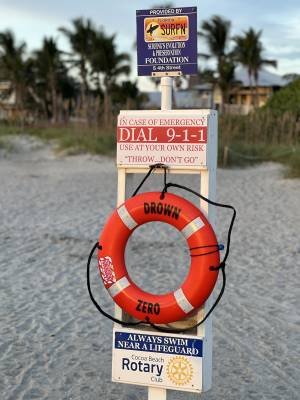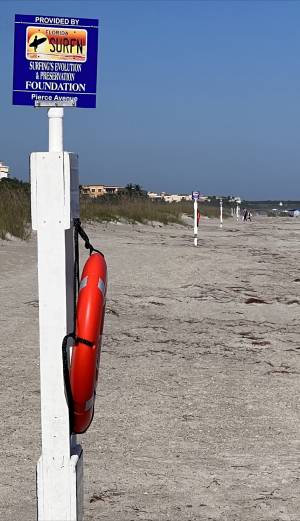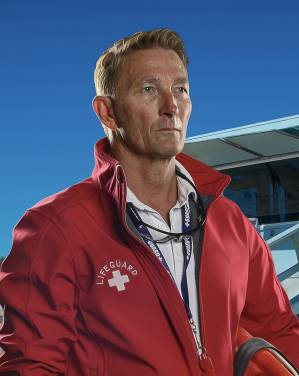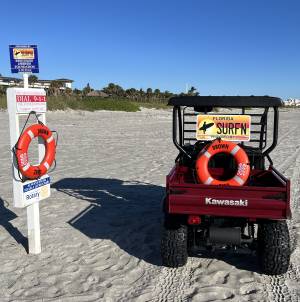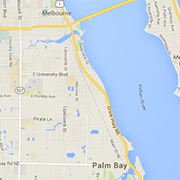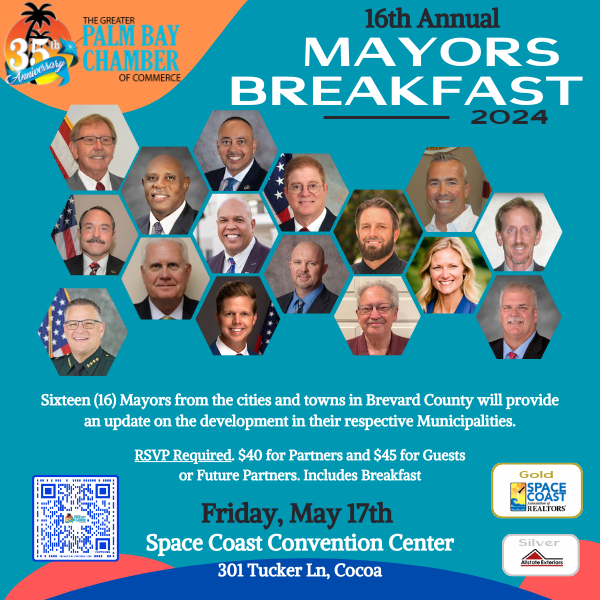Drown Zero Drastically Increases Life-Saving Potential With Unmanned Stations
In 1993, during his first week as a Brevard County lifeguard, Wyatt Werneth saved a swimmer from drowning.
As Werneth progressed to the position of chief of lifeguards, he continued saving lives by escalating efforts to establish additional lifeguard stations that would better protect the 210 beach accesses along Space Coast beaches. By the time he retired in 2008, the number had grown from 13 seasonal towers staffed the 100 or so days between Memorial Day and Labor Day to three year-round and 26 seasonal towers manned for about 200 days of the year.
The Cocoa Beach resident and spokesperson for the American Lifeguard Association realized that number was still not enough, and after retirement has continued his quest for better lifesaving coverage. Installing unmanned flotation device stations was a feasible option. The result was the birth of Drown Zero International, a nonprofit that orchestrates the installation of these stations. Each features an orange life-saving ring bystanders can use to provide assistance to distressed swimmers in the event the beach is unguarded or a lifeguard is off-duty.
Countries like New Zealand have embraced these stations as a rescue tool and personal flotation device for both rescuers and individuals in danger when no lifeguard is available. The European Resuscitation Councils and the International Lifesaving Federation, New Zealand, support the stations as an essential step in the International Lifesaving Federation’s Drowning Chain of Survival, as long as they are appropriately located and easy to use by the public.
In Florida, it’s another story. The Florida Beach Patrol Chiefs Association hasn’t supported these stations, and in a statement, “does not recommend the use of rescue ring stations at beaches, buoys on ropes, etc…to encourage the public to perform rescues,” reasoning that good Samaritans who attempt rescues often become victims themselves.
However, municipalities and groups like Rotarians happily have taken on the project. With the help of the Cocoa Beach Rotary Club and Surfing’s Evolution and Preservation Foundation, and in conjunction with the cities of Cocoa Beach and Cape Canaveral, Drown Zero installed 62 flotation device stations in just those two municipalities.
A total of 112 stations are now operational in Cocoa Beach, Satellite Beach, Indian Harbour Beach, Melbourne and Melbourne Beach, and in Hernando County on the west coast of Florida. Indian River County recently asked to be included in the list. Werneth also is negotiating with the town of Indialantic and with the county for more stations.
Brevard County Fire Rescue, which oversees the county lifeguards, is working with Drown Zero.
“My support is to public safety with board of commissioners direction,” said fire chief Patrick Voltaire.
There is no need to sell county commissioner Jason Steele on the initiative.
“Drown Zero protects our beach visitors when our lifeguards are off duty,” said the District 5 commissioner. “These rings obviously do not take the place of our professional lifeguards, but they do add a way to potentially save someone caught in a rip tide.”
The rings are designed for someone to “throw, not go” as signage on the station states. Individuals and businesses can “adopt” stations to offset maintenance costs. Donations to Drown Zero pay for the construction of the structures, built in Rockledge by Entec Innovative and installed by volunteers or city personnel.
The lifesaving rings were used in 26 rescues last year and nine already through February of this year, according to Drown Zero statistics. Adding even more stations only increases the chance to save more lives.
“We all need to get on board,” Werneth said.
Learn More
To adopt a station or for more information, visit drownzero.com or call 321-704-0151.


